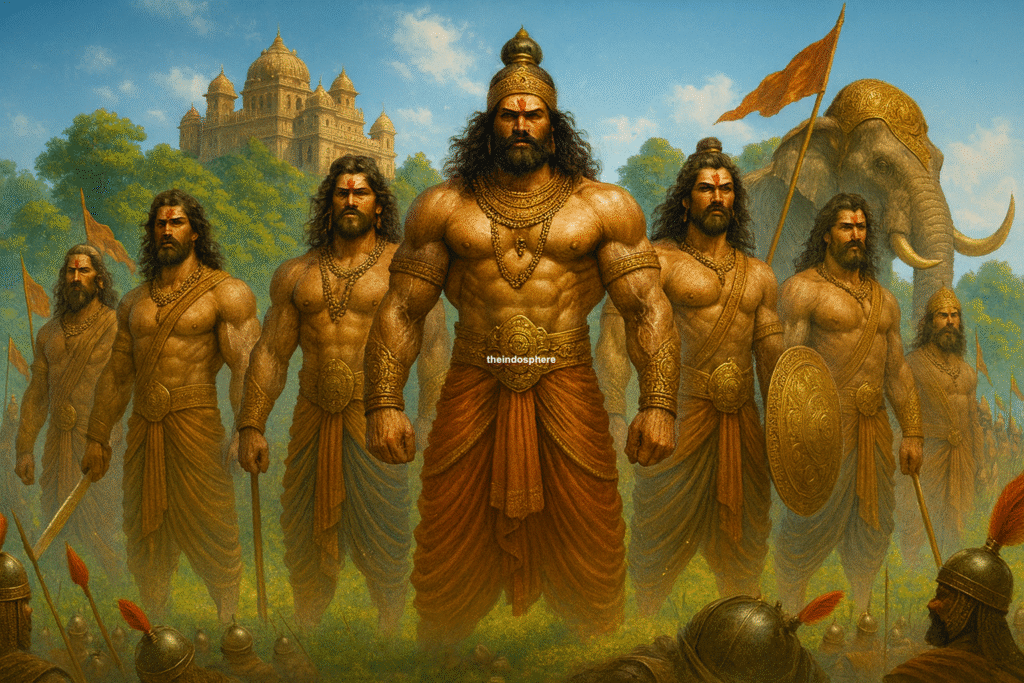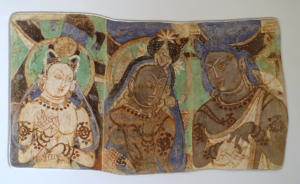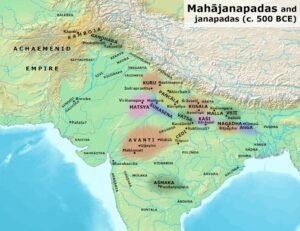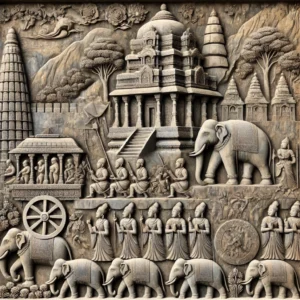Origins of the Kuru Dynasty: From the Lunar Lineage to King Kuru
The Kurus were one of the 16 Mahajanapadas (great kingdoms) that existed during the later Vedic and early historical periods of India. The Kuru dynasty was one of the most significant royal lineages of ancient India, forming the core of the Mahabharata. It originated from the Lunar Dynasty (Chandravansha) and rose to prominence with King Kuru, after whom the dynasty was named. This lineage produced powerful rulers, including Bharata, Shantanu, and the Pandavas, and eventually declined, giving way to new dynasties like the Magadha rulers.

1. The Lunar Dynasty (Chandravansha) and Its Early Kings
The Kuru dynasty descended from the Chandravansha (Lunar Dynasty), which began with Soma (Chandra, the Moon God). The early kings in this lineage were:
- Soma (Chandra) – The progenitor of the Lunar Dynasty.
- Budha – Son of Chandra, married Ila (daughter of Vaivasvata Manu).
- Pururavas – Son of Budha and Ila, known for his love story with Urvashi.
- Nahusha – A mighty ruler who was temporarily made Indra but later cursed.
- Yayati – Divided his kingdom among his five sons; his youngest son Puru was chosen to continue his lineage, which led to the Kurus.
2. The House of Puru: Direct Ancestors of the Kurus
- Puru – Established the Puru lineage, known for his dedication to dharma.
- Práchinvat → Pravira → Manasyu → Brihadratha → Kushika → Hasti
- Hasti – Founded Hastinapura, which became the Kuru capital.
- Ajamidha – A key ruler who expanded the Puru influence.
3. Founding of the Kuru Dynasty
- Bharata (Son of Dushyanta and Shakuntala)
- Established a powerful kingdom and was so influential that the land was later named Bharatavarsha after him.
- Hastin (Founder of Hastinapura)
- Hastinapura, the capital of the Kurus, was named after him.
- Kuru (The Great King of Tapasya and Dharma)
- King Kuru, after whom the dynasty was named, was known for making Kurukshetra a sacred land.
King Kuru: Founder of the Kuru Dynasty
The dynasty officially became the Kuru dynasty under King Kuru, a ruler known for his deep asceticism and righteousness.
- Kuru performed great penance at Kurukshetra, making it a sacred land.
- Due to his spiritual power, Kurukshetra was blessed as the land where dharma would always triumph.
- His descendants became known as the Kurus, forming the lineage that later ruled Hastinapura.
4. The Lineage Leading to the Mahabharata War
- Kuru
↓ - Parikshit I
↓ - Janamejaya I
↓ - Shantanu
- Father of Bhishma (from Ganga).
- Father of Vichitravirya (from Satyavati).
- His lineage played a crucial role in the Mahabharata.
↓
- Vichitravirya
- Had no biological children; his wives bore children through Vyasa.
- His sons were:
- Dhritarashtra (father of Kauravas)
- Pandu (father of the Pandavas)
- Vidura (wise minister, son of a maid, not a king)
↓
- Dhritarashtra (Kauravas) vs. Pandu (Pandavas)
- The great Kurukshetra War led to the downfall of the Kuru dynasty.
- Yudhishthira (eldest Pandava) became king after the war.
5. Post-Mahabharata War: The Kings After Yudhishthira
- Yudhishthira ruled but later renounced the throne.
- His successor was Parikshit (Son of Abhimanyu & Grandson of Arjuna).
- Parikshit was cursed to die by a snake bite and was killed by Takshaka.
- His son Janamejaya II succeeded him.
- Famous for his Sarpa Satra (snake sacrifice).
- Stopped by sage Astika, preserving the Naga race.
- Ruled over Hastinapura.
6. The Successors of Janamejaya II
- Shatanika (Son of Janamejaya II)
- A strong ruler, continued the Kuru legacy.
- Mentioned in Buddhist texts.
- Ashwamedhadatta
- Not much is known, but he likely continued the lineage.
- Adhisimakrishna (or Nichakshu)
- Shifted the capital from Hastinapura to Kaushambi due to floods.
- Udayana
- A well-known king of Kaushambi, famous in Sanskrit dramas.
- Played a role in early Buddhist stories.
- Vahinara
- Dandapani
- Niramitra
- Kshemaka (The Last Known Kuru King)
- Said to be the last recorded ruler of the Kuru dynasty.
- His reign marked the final decline of the Kuru kingdom.
7. Decline of the Kuru Dynasty
- Over time, the Kuru dynasty lost its prominence due to invasions and internal decline.
- The later Kuru rulers moved their capital from Hastinapura to Kaushambi.
- Kshemaka, the last known Kuru ruler, was defeated, marking the end of the Kuru lineage.
8. Successor Dynasties After the Kurus
After the fall of the Kurus, new dynasties rose to power, most notably in Magadha, which became the dominant kingdom in northern India:
- Shishunaga Dynasty (c. 7th-5th century BCE)
- Took over after the Kurus declined.
- Established rule in Magadha with Rajgir as its capital.
- Nanda Dynasty (c. 5th-4th century BCE)
- Overthrew the Shishunagas.
- Became the first major centralized kingdom in India.
- Expanded its influence significantly before being overthrown by Chandragupta Maurya.
- Maurya Dynasty (c. 4th-2nd century BCE)
- Established by Chandragupta Maurya, with guidance from Chanakya.
- Became one of the most powerful empires in Indian history.
- Ashoka the Great, a Maurya ruler, spread Buddhism across Asia.
The Kuru dynasty began with King Kuru and produced legendary rulers like Bharata, Shantanu, and the Pandavas. After the Mahabharata war, the dynasty continued under Parikshit and Janamejaya II, but later rulers saw a decline. The last known Kuru king, Kshemaka, marked the end of the dynasty, leading to the rise of new powerful rulers in Magadha, ultimately paving the way for the Maurya Empire.






